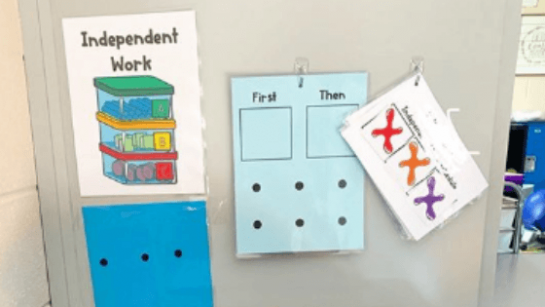How I Encourage Independence in the Classroom

January brings a new year, and, with it, a chance to reflect on past successes and set future goals! Although the particulars of each classroom are different, ultimately, all teachers share a similar goal: to prepare their students for life after school with as many independent skills as possible.
The following tips are three ways I encourage independence in my classroom and work to build my students’ skills each and every day.
1. Schedule independent work time.
I firmly believe that every student needs to be practicing independent work skills every single day. All students can complete some level of independent work, even if it’s only for a few minutes at a time! For this reason, there should be time in your classroom schedule for independent work, and it should be a normal part of your classroom routine.
Independent work does not have to be fancy and can be a simple fine motor task, a review of old skills, or a binder that has critical skills students practice every day. Another potential option for independent work is assigning practical jobs that need to be done around the classroom like sharpening pencils, wiping down tables, or shredding papers.
2. Teach important skills during daily routines.
Students have to do dozens of tasks a day that are great opportunities to practice independence! For some students, this may be adaptive behavior skills like putting on a jacket or going through the lunch line independently. Meanwhile, other students might be able to practice routines when it comes to organizing their locker, creating to-do lists for longer assignments, or keeping a planner.
Think through your day and which routines your students struggle with and identify how you can proactively teach these skills. You might need to adjust your schedule by a few minutes to allow for independent practice or provide different visual supports for specific routines. The important thing is to plan for teaching and practicing of these skills, and to teach and practice them within the currently existing routine of your day!
3. Gain staff buy-in.
Students will reach the greatest levels of independence when all staff members are working together to teach and encourage new independent skills. It’s a natural inclination to jump in and help students when they are struggling, so encourage staff to remind each other to take a step back and follow the prompt hierarchy.
It’s normal for teachers and paras to hold each other accountable for this, but think about ways to involve your admin, gen-ed teachers, or related arts teachers as well! One possibility is to send a monthly or weekly email to the school with an independent skill ‘focus’ and ideas for how to encourage that skill in different contexts. This will help generalize skills to new settings and help students reach their full potential.
What are some of your best tips to encourage student independence? Comment below and share them with us!
